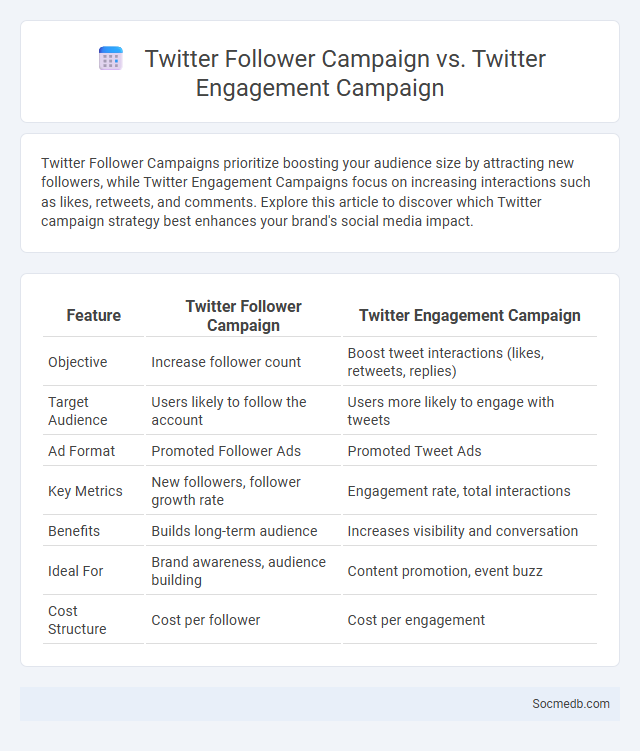
Photo illustration: Twitter Follower Campaign vs Twitter Engagement Campaign
Twitter Follower Campaigns prioritize boosting your audience size by attracting new followers, while Twitter Engagement Campaigns focus on increasing interactions such as likes, retweets, and comments. Explore this article to discover which Twitter campaign strategy best enhances your brand's social media impact.
Table of Comparison
| Feature | Twitter Follower Campaign | Twitter Engagement Campaign |
|---|---|---|
| Objective | Increase follower count | Boost tweet interactions (likes, retweets, replies) |
| Target Audience | Users likely to follow the account | Users more likely to engage with tweets |
| Ad Format | Promoted Follower Ads | Promoted Tweet Ads |
| Key Metrics | New followers, follower growth rate | Engagement rate, total interactions |
| Benefits | Builds long-term audience | Increases visibility and conversation |
| Ideal For | Brand awareness, audience building | Content promotion, event buzz |
| Cost Structure | Cost per follower | Cost per engagement |
Overview of Twitter Advertising Campaign Types
Twitter advertising campaigns include various types such as promoted tweets, promoted accounts, and promoted trends, each designed to target specific user engagements. Promoted tweets enhance visibility in timelines, promoted accounts boost follower numbers, and promoted trends increase awareness around specific hashtags. Your brand can leverage these options to tailor campaign objectives like website clicks, app installs, or follower growth for optimized social media marketing results.
What is a Twitter Follower Campaign?
A Twitter Follower Campaign is a targeted marketing strategy designed to increase the number of followers on your Twitter account, enhancing brand visibility and engagement. By leveraging specific audience targeting options such as demographics, interests, and behaviors, you can attract relevant followers who are more likely to engage with your content. Your campaign's success depends on creating compelling tweets and offers that resonate with the desired audience to build a loyal community.
What is a Twitter Engagement Campaign?
A Twitter Engagement Campaign is a strategic marketing effort designed to increase interactions such as likes, retweets, replies, and clicks on tweets. This type of campaign leverages targeted hashtags, compelling content, and Twitter Ads to boost visibility and foster user participation. Brands use these campaigns to enhance audience engagement metrics, improve brand awareness, and drive traffic to websites or landing pages.
Understanding Twitter Ad Campaign Objectives
Twitter ad campaign objectives target specific marketing goals to maximize your reach and engagement on the platform. Choosing the right objective, such as brand awareness, website traffic, or app installs, directly influences ad formats and bidding strategies. Understanding these objectives enables you to create tailored content that resonates with your audience and drives measurable results.
Key Differences Between Follower, Engagement, and Ad Campaigns
Follower campaigns prioritize increasing the number of users who subscribe to a brand's social media profile, aiming to build a long-term audience base. Engagement campaigns focus on boosting interactions such as likes, comments, shares, and clicks to enhance content visibility and foster community participation. Ad campaigns are designed to achieve specific marketing objectives, utilizing targeted ads to drive conversions, website traffic, or sales beyond organic reach.
Pros and Cons of Twitter Follower Campaigns
Twitter follower campaigns can significantly boost your social media presence by rapidly increasing your follower count, enhancing brand visibility, and driving greater engagement with targeted audiences. However, these campaigns may attract low-quality or non-genuine followers, potentially reducing overall engagement rates and affecting your credibility. Carefully managing the campaign ensures that your Twitter followers are relevant and contribute to meaningful interactions.
Pros and Cons of Twitter Engagement Campaigns
Twitter engagement campaigns boost brand visibility by fostering real-time interaction with a broad audience, enhancing customer loyalty and driving website traffic. However, the platform's fast-paced environment demands consistent content updates and monitoring to maintain engagement and manage potential negative feedback effectively. Campaigns may also face challenges with organic reach limitations, requiring budget allocation for promoted tweets to achieve desired impact.
Cost Comparison: Follower vs Engagement vs Ad Campaigns
Analyzing social media marketing costs reveals that follower acquisition is typically the least expensive, averaging between $0.10 to $2 per follower, but often results in lower engagement rates. Engagement-focused strategies, including organic content and influencer partnerships, cost more yet generate higher interaction quality, with average engagement rates ranging from 1% to 5% of total followers. Your budget allocation for ad campaigns varies widely, ranging from $0.50 to $5 per click or impression, offering targeted reach and measurable ROI for conversions compared to follower growth or engagement initiatives.
When to Use Each Type of Twitter Campaign
To maximize engagement and reach on Twitter, use Awareness campaigns when launching new products or building brand visibility, as they prioritize impressions and broaden your audience. Choose Consideration campaigns, such as Traffic or Video Views, to drive users to your website or increase video engagement, helping you nurture interest and interaction. For conversions or specific actions, leverage Conversion campaigns to target users with intent, ensuring Your ads deliver measurable results like sign-ups, purchases, or app installs.
Tips for Choosing the Right Twitter Campaign Type
Selecting the right Twitter campaign type depends on clearly defined goals such as brand awareness, lead generation, or website traffic. Promoted Tweets suit those aiming to boost engagement and visibility, while Twitter Ads with video or carousel formats work best for showcasing products and driving conversions. Analyzing audience demographics and campaign objectives ensures optimal targeting and maximizes return on investment for each advertising strategy.
 socmedb.com
socmedb.com